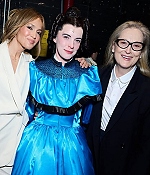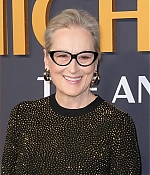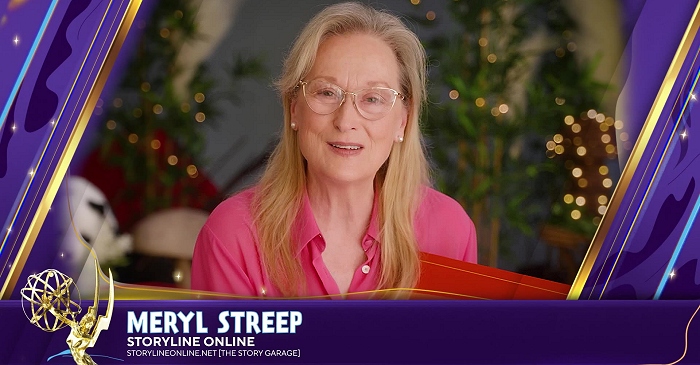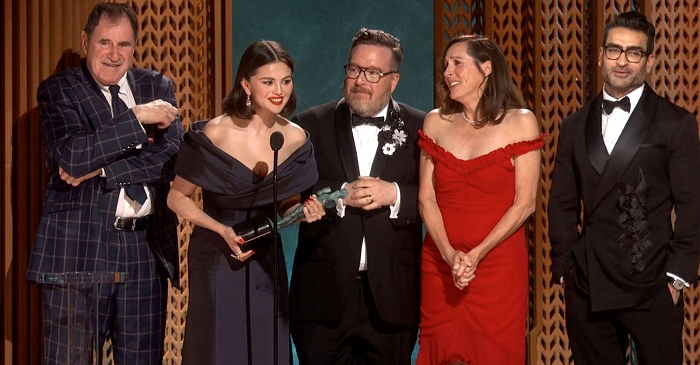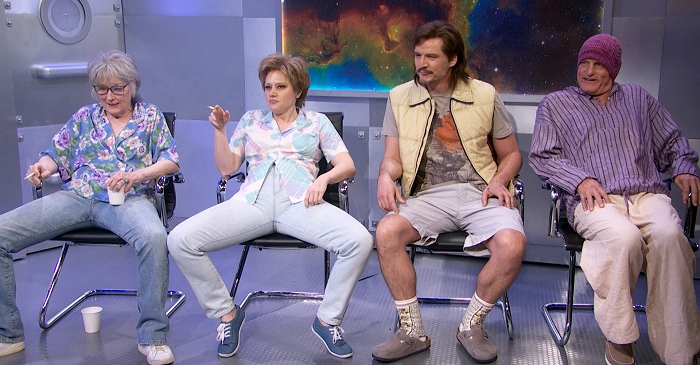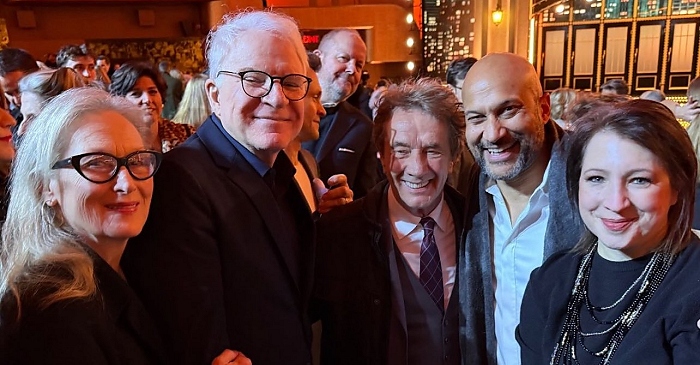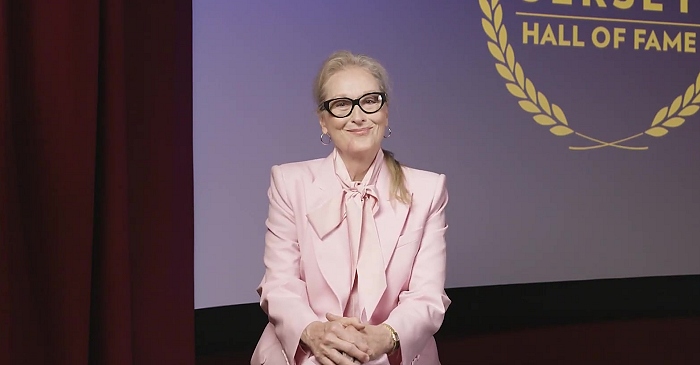|
Simply Streep is your premiere source on Meryl Streep's work on film, television and in the theatre - a career that has won her the praise to be one of the world's greatest working actresses. Created in 1999, we have built an extensive collection to discover Miss Streep's body of work through articles, photos and videos. Enjoy your stay.
|
Celebrating
25 years
of SimplyStreep
|
|
Radio for the Eyes
The Washington Post ·
July 28, 2005
· Written by Peter Kaufman
|
Preparing to rehearse a scene on the set of his latest project, Robert Altman, the dean of American film directors, says: “I don’t even know what’s in the script.” He’s not a bit concerned about that, either. He is, in fact, describing his customary way of working. Waiting for technicians to solve some problem, he leans back in a director’s chair – exactly like the ones you have in your rec room, except that yours don’t say ROBERT ALTMAN on the back.
“I’ll go to set a scene up,” Altman continues, “and I’ll ask the actors what it is, or I’ll ask the script supervisor: ‘What is this scene, what is this about, what do they say in it?’ But at the end of the scene, I don’t know whether they’ve said the dialogue or not.” This unorthodox method has worked out pretty well for Altman. In his 1970 breakthrough, “M*A*S*H,” and in “McCabe and Mrs. Miller,” “The Player,” “Short Cuts” and the Best Picture nominees “Nashville” (1975) and “Gosford Park” (2001), one of Altman’s hallmarks is the spontaneity, the naturalness, of the scenes. The speech on the page is merely the springboard. Still, it’s a little surprising to see him take that approach on the current movie: an adaptation of “A Prairie Home Companion,” the venerable weekend variety show on public radio. The screenplay was written by “Prairie” creator and host Garrison Keillor, who is also a novelist and essayist. Words matter to him. He selects them painstakingly. Moreover, Keillor is on the set nearly every day, because in the film he is playing himself – or at least he’s playing the host of a radio broadcast. He is there watching as the actors and director, again and again, futz with his lines, moosh separate scenes together into one, add morsels of their own.
“It’s very difficult for him,” Altman observes. “It’s the first time he’s had anybody that can override him. . . . I have the editing control. But he’s smart enough – he knows that.” Somewhat wistfully, Altman adds: “I don’t know if he’s having any fun .” He is, though. During an hour-long conversation in a spacious dressing room upstairs at the Fitzgerald Theater here, Keillor marvels at the notion that Meryl Streep and Kevin Kline and Lily Tomlin, among others, are bringing to life characters he invented. “I find it really breathtaking and amazing to see actors working up a role,” he says. “I’ve never seen this before. All of the acting that’s done on our show is just kind of instant, immediate stuff.”
He speaks in the soothing, resonant croon known so well to the 4.3 million listeners of “PHC,” which first took the air in 1974. A descendant of vaudeville, Jack Benny, the Grand Ole Opry and possibly Firesign Theatre, “PHC” is a two-hour weekly valentine to, and gentle satire of, heartland America. It emanates most frequently from the Fitzgerald, the oldest existing theater in St. Paul, and the entire broadcast is flavored by Keillor’s affectionate depiction of Minnesotans as self-effacing and buttoned up. The musical acts incline toward bluegrass and blues, with a jazz chanteuse here and there. (The host himself will sometimes sing a tune or, with perfect earnestness, a hymn.) The imaginary sponsors, whose “ads” are written by the host, include Bertha’s Kitty Boutique, Powdermilk Biscuits, the Ketchup Advisory Board and the Cafe Boeuf, which is presided over by Maurice, the world’s haughtiest French maitre d’. Joined by actors Tom Russell and Sue Scott, Keillor appears in sketches about retro private eye Guy Noir or Dusty and Lefty, two old cowpokes who pass the long hours on the trail by sniping at each other. And there is the News From Lake Wobegon: Standing at center stage with nary a note in his hand, Keillor uncorks a shaggy-dog story, lasting 15 minutes or so, about events that, in the seven days past, purportedly befell various citizens of that fictional Minnesota town. The tale is often funny, sometimes poignant, always observant, and the theater audience is unfailingly transfixed by it. Just a man talking extemporaneously for a quarter-hour, and people actually pay attention. “He’s just the best at radio management and production that I’ve ever seen,” says Russell, a St. Paul native who also co-hosts a morning show on WCCO, a Minneapolis news-talk station, and has worked in the medium for more than 30 years. On Keillor’s show, a sketch will sometimes call for Russell to utter impassioned gibberish that sounds like Swedish, Italian, Russian or French (he plays snooty Maurice). He also does perhaps the best vocal impersonation of George W. Bush extant, so the president turns up on the show sometimes.
“PHC” may be great radio, but who would ever regard it as boffo movie potential? “I didn’t see the film in it,” Altman recalls. “It was a real challenge: How can we make this work?” “It was his idea,” Keillor says. “And I didn’t care for the idea, but I found him intriguing and I still do.” So Keillor got to work on a screenplay about a St. Paul radio program called “Prairie Home Companion” – the movie may or may not bear that title – hosted by someone who is usually addressed as GK. The show is carried not on a nationwide network but by one station, WLT. That’s because the plot requires the station to be sold to a greedy Texas corporation, which sends a hatchet man (played by Tommy Lee Jones) to close down the show and fire everybody. But the story’s not really the thing here. A look at about 45 minutes of footage indicates that the film will emphasize backstage shenanigans and musical numbers performed by the actors. “I like the fact that the story is fairly simple and straightforward,” says the man who wrote it, “and so it allows all these different, lovely acting turns.”
To get his favorite characters into the movie, Keillor had to turn some elements of the show inside out. The film couldn’t be “a bunch of actors standing around holding scripts,” he says. “I mean, that would be funny for 45 seconds.” So Dusty and Lefty, played by Woody Harrelson and John C. Reilly, have hung up their spurs and are now radio cowboys, strumming guitars and singing bawdy ditties. Guy Noir, the gumshoe played by Kline, has shuttered his office on the 12th floor of the Acme Building to become head of security for the radio show. Scott and Russell, who voice any number of characters on the real “PHC,” here portray a makeup artist and the stage manager, respectively. Lake Wobegon is not mentioned in the movie. ‘That Dart Board’ Nearly the entire film is being shot inside the Fitzgerald, a sturdy house with a sandstone facade that, when built in 1910, was part of the Shubert chain. Once the day’s work commences at 11 a.m., the stage overspills with technicians, actors, carpenters, electricians. A scene is being shot just off the Fitz’s stage, in a tiny room made up as Guy Noir’s office. The theater’s basement, too, has been transformed into various settings. It’s as crowded as an ant farm. People are always squeezing by each other, carrying cables and props and big yellow trunks full of who knows what.
But when it’s time to rehearse a sequence, the hubbub subsides. Seated maybe 15 feet from the actors, Altman looks at two video monitors. He likes to film with two cameras simultaneously, and the monitors show him the view from each. Two other monitors relay the same information to Ed Lachman, the film’s veteran cinematographer. The rehearsal begins, and as many as a dozen crew members crowd around the two sets of monitors. They watch as intently as the engineers at Mission Control during the shuttle launch. The chief lighting technician, the production designer, the camera assistant, the prop master, they’re all there, whispering and pointing at the screens. They’re looking for glitches, for things that never should make the movie – the shadow of a microphone boom, an unwanted reflection in a mirror – or just for things that don’t look good. This movie is being made quickly. It has a shooting schedule of 25 days, and Altman is finishing it a few days early (the day you read this, in fact). But even for the briefest scene, rehearsals and then filming can take hours. Altman maintains a stream of chatter to keep cobwebs from forming. He’ll sing a few lines of “Don’t Get Around Much Anymore,” or ask an onstage musician how much a saxophone costs. Peering at the monitor, the director takes a sudden dislike to a prop that is affixed to the wall. “That dart board has been in every set of every movie I’ve ever made,” he growls. “We can put a deer head and antlers there instead,” suggests a crew member. “Or dogs playing poker,” says another. “We remember your request for that dart board,” the first adds. “That’ll teach you something,” Altman replies. “Not to pay attention to my requests.”
Streep and Tomlin, who play the Johnson Girls, a midwestern singing-sister act, finished their scenes the previous week and are long gone. So, too, Lindsay Lohan. Did we mention Lindsay Lohan? She plays Streep’s daughter, who doesn’t want to join the family business of old-timey music. The streets of St. Paul haven’t seen so many paparazzi since Jesse Ventura got elected. “It’s definitely quieter now,” a crew member says with evident relief. Altman says it was no big deal directing the 19-year-old tabloid queen. In her other films, he notes, “she’s been the star, so everybody’s kind of kowtowed to her. I think here she was just one of the performers. But she did it very well. . . . “All her scenes were with Meryl Streep and Lily Tomlin and Garrison, so she was self-policed. There was no nonsense about it.” Now, with most of the female stars gone, the nonsense truly begins. Kline, Harrelson and Reilly (as Guy Noir, Dusty and Lefty) gather for a scene in which the cowboys, standing outside a dressing room, must deliver tragic news to the detective, who then questions them. The scene is straightforward, but Reilly has come up with a modification: as Noir is questioning the old trailhands, there will be a sudden and very audible signal of intestinal distress. Actors can produce tears on demand, but bodily gases are another matter. Reilly has dispatched someone to purchase one of those little prank machines that produce, in several convincing varieties, the unmistakable sound of flatulence. When Noir reaches a certain point in his interrogation, Reilly surreptitiously triggers the device. The noise is quite loud. It has verisimilitude. Over at the monitor, Altman shakes with silent laughter.
What makes it funny is that the actors never acknowledge the interruption. They just stare at each other for a few long seconds, completely deadpan, and then proceed with their lines. At scene’s end, just as he and Harrelson amble off camera, Reilly sets off another depth charge. The camera stays with Kline, who stares after him, perplexed, pained. And: Cut ! “Nice dialogue, Reilly!” Altman calls out. The scene goes through several rehearsals, then filmings. Each time the crew nearby breaks up – well, half of the crew does. One female crew member turns to another and says, “Such a guy thing.” Altman wants one more take, but the technicians need a timeout. Several minutes pass and Altman grows impatient. What’s the holdup, he demands. “The fart machine is on the fritz!” a crew member calls back.
Early one afternoon, a pizza is brought to the stage of the Fitz, where Altman is set up. Lunch break won’t be until 5 p.m., so the slender kid who has been sitting at Altman’s right elbow for a while springs up and fetches a slice for the director. A few minutes bring the arrival of Virginia Madsen, who portrays a character called Dangerous Woman. Smiling brightly, Madsen presents Altman with a White Castle cheeseburger from the pile that the caterers left in the lobby. At another point, Reilly reports for his day’s work, dressed in full Lefty regalia: Stetson, neckerchief, chaps. He stops by Altman’s station. “Good morning there, Mr. Cowboy,” Altman greets him. “How are you? Listen, I’ve got a scene coming up here with you where you don’t have any words to remember.” “My favorite kind,” Reilly replies cheerily. Actors have always wanted to work for Robert Altman, and so it is on this set. Maya Rudolph, the “Saturday Night Live” stalwart who plays an assistant stage manager in this film, speaks admiringly of Altman’s ability to capture the “natural disarray” in human interaction. Reilly calls it “controlled chaos.” For the chance to be in his films, which are always commercially iffy, actors leave money on the table. Madsen, who is coming off an Oscar nomination for “Sideways” and is fielding the most lucrative offers of her career, says, “Everybody’s doing it for scale.” Keillor says he and his collaborator are “entirely unlike,” and in many respects that’s true. For much of his career, Altman was a dedicated carouser; Patrick McGilligan, the author of a 1989 biography, describes the director in the late 1940s as having “a tireless personality and a loose zipper.” The Minnesotan is a solitary fellow who says, “My idea of the way to spend your life was to sit at your dining-room table and write.”
But the writer and the director are both midwesterners. On a tree-shaded, well-kept block in the pleasant Brookside neighborhood of Kansas City still stands the bungalow where Altman spent his first few years. (Erica Eimer, who lives there, says she and her husband are “indie-film buffs,” but that they had no idea when they bought the house that it once belonged to the Altmans.) Unlike Spielberg, Lucas, Scorsese and the other great American directors who emerged in the 1970s, Altman was already middle-aged by the time he made his mark with “M*A*S*H.” He had spent two decades making industrial films and toiling on TV series. Habits of efficiency became ingrained. And so, again like Keillor, Altman has stayed remarkably prolific. Not for him the icy perfectionism of a Stanley Kubrick, who would insist on scores of takes for the simplest scene. “I just do not understand that,” Altman says in his flat Missouri drawl. “Never did. Didn’t at the time. Still don’t.” In this film, as in “Nashville,” the actors do their own singing. Some are more suited to this than others. Streep, wearing a ruffly dress in her performance scenes, reveals a magnificent, powerful singing voice. Reilly and Harrelson, the cowboys, spend long hours one afternoon trying bravely to master four lines from the 1890s lament “She’s More to Be Pitied Than Censured”:
Don’t scorn her with words fierce and bitter
Do not laugh at her shame and downfall
For a moment, just stop and consider
That a man was the cause of it all
Rich Dworsky, the bandleader on Keillor’s radio show and in this film, assists the troubadours, picking out the melody on a piano for Reilly and placing his hand in the air at different levels to show Harrelson how the harmony goes up and down. Stubborn progress is achieved. Reilly, who had a number in the film “Chicago,” is no trained vocalist, but next to Harrelson – literally next to him – he is Mario Lanza. That kid with the close-cropped hair, the one who served the pizza to Altman, is still sitting next to him. The two are deep in conversation. An inquiry is made, and the kid turns out to be Paul Thomas Anderson, the fireballing young phenom of Hollywood who directed “Magnolia,” “Boogie Nights” and “Punch-Drunk Love.” (He is 35 but looks younger.) He’s not just stopping by to say hi. These days, for Altman, 80, to obtain financing for a film, he must designate a standby director who can complete the work if necessary. The director’s chair where Anderson sits is imprinted with the words PINCH HITTER.
Further, he is the companion of Maya Rudolph, who will have their baby this fall and whose pregnancy has been written into the script. The film crew seems a mite hinky about discussing Anderson’s duties here. They prefer to speak of Anderson as Altman’s pal (which he is), who is just kind of hanging out and lending a hand. But Altman doesn’t mind broaching the subject squarely: “If I croaked or lost a day, Paul is here and he could take over and shoot any of this stuff at any time.” There will surely be a soundtrack CD, but much else about the “PHC” movie is uncertain. It doesn’t have a distributor yet, let alone an opening date. David Levy, a producer, says the picture might be shopped around at the Sundance Film Festival in January. So the work of Levy and the other producers is really just beginning. Altman, too, must oversee the editing of the movie once shooting is completed. But most of Keillor’s work is done. He’s just enjoying the ride now. Keillor probably isn’t calling his agent and begging for more movie roles. Even on radio, he says, “I have less urge to perform than the average 10-year-old girl. I enjoy it, but it’s not a big deep urge somehow.” That’s easy to believe when you realize that he never speaks his own name on the air. If he must be identified when playing himself in a radio sketch, that character is called “Carson Wyler.” “He wanted to call himself Carson Wyler in the movie,” says his radio cohort Sue Scott, “and I guess Altman said, No, you gotta be Garrison Keillor.” When Altman and his caravan have finally opened their movie and meandered off to another subject, Keillor, who turns 63 next month, will steadfastly tend his radio show. After 30 years, he says, “A Prairie Home Companion” is still a work in progress. “I think it’s got life left in it,” he says. “I keep feeling that it’s ready to turn a corner and develop in some new way. “I don’t have a clear vision of this yet. But I don’t feel that I’ve done the show that I really want to do. I think I’m still kind of searching for it.”

